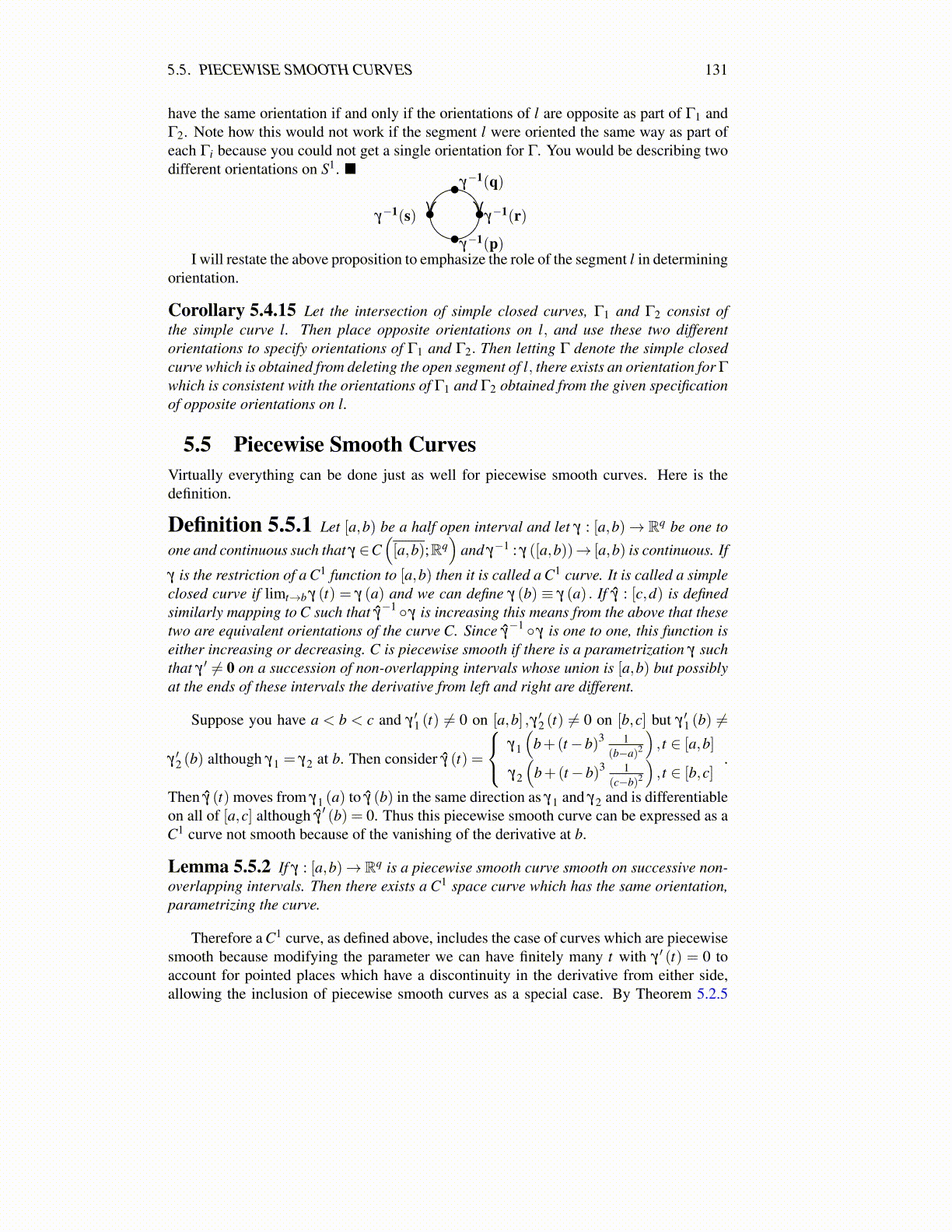
5.5. PIECEWISE SMOOTH CURVES 131
have the same orientation if and only if the orientations of l are opposite as part of Γ1 andΓ2. Note how this would not work if the segment l were oriented the same way as part ofeach Γi because you could not get a single orientation for Γ. You would be describing twodifferent orientations on S1. ■
γ−1(q)
γ−1(s) γ−1(r)
γ−1(p)I will restate the above proposition to emphasize the role of the segment l in determining
orientation.
Corollary 5.4.15 Let the intersection of simple closed curves, Γ1 and Γ2 consist ofthe simple curve l. Then place opposite orientations on l, and use these two differentorientations to specify orientations of Γ1 and Γ2. Then letting Γ denote the simple closedcurve which is obtained from deleting the open segment of l, there exists an orientation for Γ
which is consistent with the orientations of Γ1 and Γ2 obtained from the given specificationof opposite orientations on l.
5.5 Piecewise Smooth CurvesVirtually everything can be done just as well for piecewise smooth curves. Here is thedefinition.
Definition 5.5.1 Let [a,b) be a half open interval and let γ : [a,b)→ Rq be one to
one and continuous such that γ ∈C([a,b);Rq
)and γ−1 : γ ([a,b))→ [a,b) is continuous. If
γ is the restriction of a C1 function to [a,b) then it is called a C1 curve. It is called a simpleclosed curve if limt→b γ (t) = γ (a) and we can define γ (b) ≡ γ (a) . If γ̂ : [c,d) is definedsimilarly mapping to C such that γ̂
−1 ◦ γ is increasing this means from the above that thesetwo are equivalent orientations of the curve C. Since γ̂
−1 ◦ γ is one to one, this function iseither increasing or decreasing. C is piecewise smooth if there is a parametrization γ suchthat γ ′ ̸= 0 on a succession of non-overlapping intervals whose union is [a,b) but possiblyat the ends of these intervals the derivative from left and right are different.
Suppose you have a < b < c and γ ′1 (t) ̸= 0 on [a,b] ,γ ′2 (t) ̸= 0 on [b,c] but γ ′1 (b) ̸=
γ ′2 (b) although γ1 = γ2 at b. Then consider γ̂ (t) =
γ1
(b+(t−b)3 1
(b−a)2
), t ∈ [a,b]
γ2
(b+(t−b)3 1
(c−b)2
), t ∈ [b,c]
.
Then γ̂ (t) moves from γ1 (a) to γ̂ (b) in the same direction as γ1 and γ2 and is differentiableon all of [a,c] although γ̂
′ (b) = 0. Thus this piecewise smooth curve can be expressed as aC1 curve not smooth because of the vanishing of the derivative at b.
Lemma 5.5.2 If γ : [a,b)→ Rq is a piecewise smooth curve smooth on successive non-overlapping intervals. Then there exists a C1 space curve which has the same orientation,parametrizing the curve.
Therefore a C1 curve, as defined above, includes the case of curves which are piecewisesmooth because modifying the parameter we can have finitely many t with γ ′ (t) = 0 toaccount for pointed places which have a discontinuity in the derivative from either side,allowing the inclusion of piecewise smooth curves as a special case. By Theorem 5.2.5